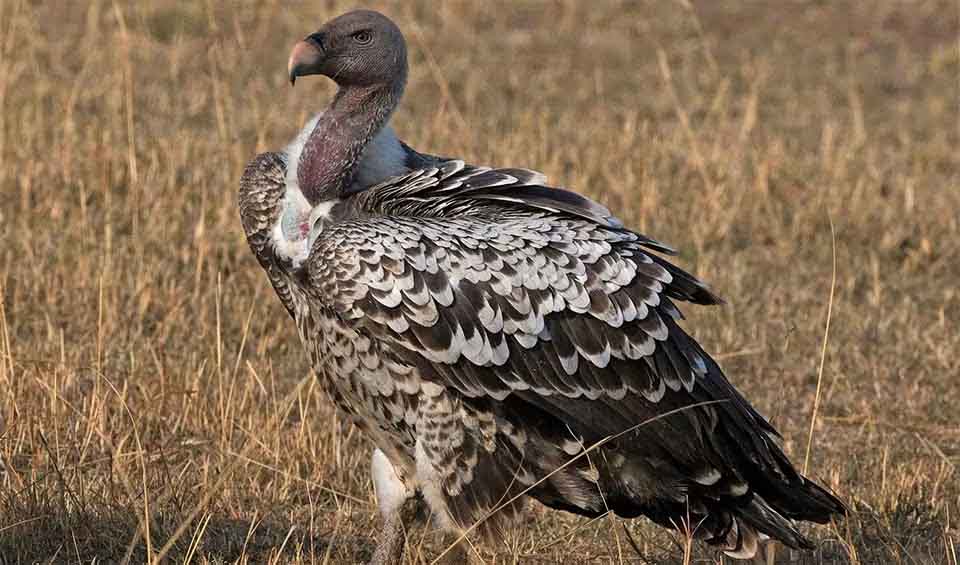A Rüppell’sstriking and sociable bird of prey that inhabits the vast skies and open landscapes of sub-Saharan Africa. Named in honor of the German naturalist Eduard Rüppell, these vultures are a sight to behold with their majestic appearance and fascinating behaviors.
One of the most notable characteristics of Rüppell’s vulture is its social nature. Often seen congregating in groups, these vultures engage in silent gatherings, punctuated only by occasional vocalizations, particularly when scavenging on carcasses. Their communal feeding behavior is essential for their survival, as it allows them to efficiently locate and consume carrion, playing a crucial role in the ecosystem’s nutrient cycling process.
Despite their formidable appearance, Rüppell’s vultures possess unique adaptations for their scavenging lifestyle. Their bodies are adorned with a dense layer of downy feathers, providing insulation and protection from the elements. Interestingly, while their bodies are covered in feathers, their heads and necks are bare, which helps to prevent bacterial buildup when feeding on carcasses.
During moments of excitement or displays of dominance, the skin on their necks can flush bright red, adding to their already impressive appearance. This visual cue serves as a signal to other vultures, indicating their social status within the group hierarchy.
Rüppell’s vultures are primarily scavengers, feeding on the remains of large animals such as ungulates. Contrary to popular misconceptions, scavenging requires considerable energy and effort, as vultures must locate, assess, and compete to access carcasses. Despite their vital ecological role, these vultures face numerous threats, including habitat loss, poisoning from ingesting contaminated carcasses, and human persecution.
The decline in Rüppell’s vulture populations has raised concerns among conservationists, leading to efforts to protect and conserve these magnificent birds. Conservation initiatives focus on addressing the underlying causes of population decline, including habitat degradation, reducing human-wildlife conflict, and implementing measures to mitigate the impacts of poisoning.
Distribution
 Algeria
Algeria Benin
Benin Botswana
Botswana Burkina Faso
Burkina Faso Burundi
Burundi Cameroon
Cameroon Central Af. Rep.
Central Af. Rep. Chad
Chad Côte D’ivoire
Côte D’ivoire DR Congo (Kinshasa)
DR Congo (Kinshasa) Djibouti
Djibouti Egypt
Egypt Eritrea
Eritrea Ethiopia
Ethiopia Official estimate
Official estimate
 Gambia
Gambia Ghana
Ghana Gibraltar
Gibraltar Guinea-Bissau
Guinea-Bissau Guinea
Guinea Kenya
Kenya Official estimate
Official estimate
 Lesotho
Lesotho Malawi
Malawi Mali
Mali Mauritania
Mauritania Morocco
Morocco Mozambique
Mozambique Namibia
Namibia Niger
Niger Nigeria
Nigeria Portugal
Portugal Rwanda
Rwanda Saudi Arabia
Saudi Arabia Senegal
Senegal Sierra Leone
Sierra Leone Somalia
Somalia South Africa
South Africa South Sudan
South Sudan Spain
Spain Sudan
Sudan Official estimate
Official estimate
 Tanzania
Tanzania Official estimate
Official estimate
 Togo
Togo Uganda
Uganda Zambia
Zambia Zimbabwe
ZimbabweAnything we've missed?
Help us improve this page by suggesting edits. Glory never dies!
Suggest an editGet to know me
Terrestrial / Aquatic
Altricial / Precocial
Polygamous / Monogamous
Dimorphic (size) / Monomorphic
Active: Diurnal / Nocturnal
Social behavior: Solitary / Pack / Herd
Diet: Carnivore / Herbivore / Omnivore / Piscivorous / Insectivore
Migratory: Yes / No
Domesticated: Yes / No
Dangerous: Yes / No





